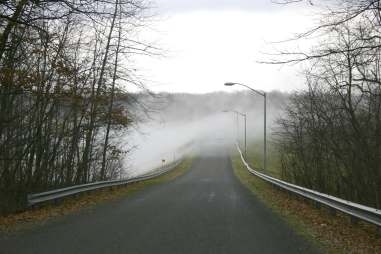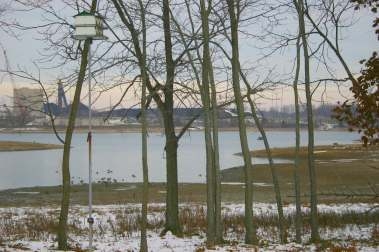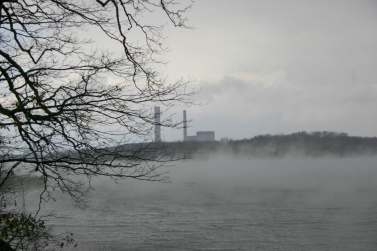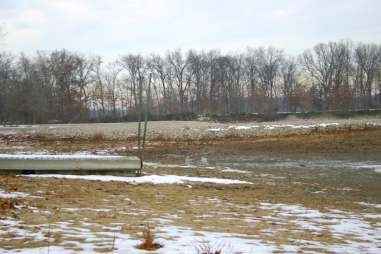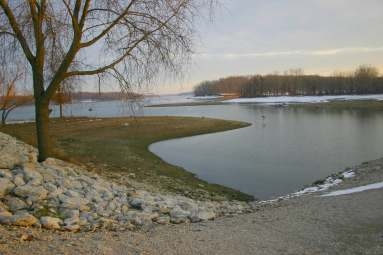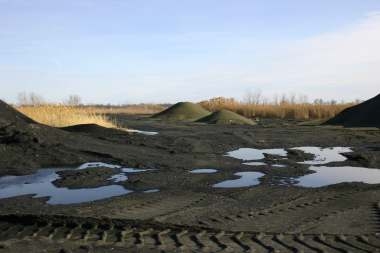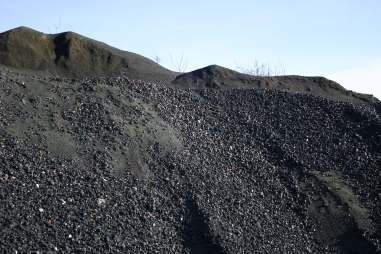Mary A. Bates
936 Vandalia Street
Hillsboro, Illinois 62049
maryhelfer@consolidated.net
217-532-2708
July 13, 2009
John Therriault
Illinois Pollution Control Board
100 West Randolph, Suite 11-500
Chicago, Illinois 60601
Re: Ameren Energy Generating Company
PCB 2009-038 thermal Demonstration
Dear Sir:
I am a resident of Hillsboro, Illinois and have concerns about the proposal to raise the
temperature in Coffeen Lake. I visit the Coffeen Lake frequently and have friends who boat
and fish on the lake. I am a member of Citizens Against Longwall Mining (CALM) and
Illinois Sierra Club. We will all be adversely affected if the temperature is allowed to be
raised at any time during the year.
There is an additional problem that was never mentioned during the hearings.
The Deer Run Mine is scheduled to longwall mine with the planned subsidence in the area
under McDavid Branch.
I attended the Litchfield hearings on June 23, 2009 and nothing was mentioned about the
Deer Run Mine subsidence affecting McDavid Branch. McDavid Branch is located in the shadow
area of the mine in sections 5, 22 and 27 of East Fork Township. Mining is scheduled to begin
in 2010 and continue through 2015 with seven longwall panels. Five of those panels will go
under Route 185 and will most assuredly affect the watershed feeding into Coffeen Lake.
If McDavid Branch is subsided during the longwall mining process the water may be greatly
diminished or disappear all together. According to the Illinois Permanent Program, IDNR should
require subsided areas to be reclaimed. However, if the damage from subsidence is technologically
and economically unfeasible then the area is not required to be reclaimed. 62 IAC 1817.121 (a) (1).
Additionally, the Office of Surface Mining, Andrew Gilmore, Regional Manager, informed CALM
members that subsidence is not considered a mining activity and reclamation is not required. (United
States Court of Appeals 6/3/2003 No. 02-5136 Citizens Coal Council , et al. vs.. Gale Norton Sec.
of Interior, National Mining Assoc.) Also citizens complaints must exhaust the Illinois Permanent
Program/SMCRA rules before OSM would consider complaints against IDNR.
I have included photos of Coffeen Lake I took March, 2009 showing steam rising from the
lake and obscuring the road over the dam. Also included are photos taken during the drought
of December 2007. This is the lowest lake level ever seen. If the watershed is damaged by
subsidence and McDavid Branch is unable to flow into Coffeen Lake then these photos will
be much worse.
I'm also concerned about the runoff into the lake from the coal waste at the US Minerals site
on Fox Avenue. Are there test wells in place to monitor the runoff? Was a liner placed under
the coal combustion waste to prevent seepage into the lake? Where are the air monitoring
stations? The residential area is a short distance to the left of the photo #6265. What is
being done to protect these people during high winds?
There are many unanswered questions with this Ameren site. The lax enforcement
of the rules by IDNR and IEPA to protect the health and welfare of the public is evidenced
by the number of litigation cases now in the progress. It is my hope the construction of
the new ash pit just south of Fox Avenue will follow the rules and protect the public with
a liner and air monitoring systems in place before the new scrubbers come on line.
Hopefully the new dewatering technology now available will be used for the ash slurry
(see attached).
I hope the Pollution Control Board will take responsibility to protect the Coffeen Lake
and it will not become another superfund site as the Eagle Zinc Smelter (Hillsboro) and
ASARCO, Inc (Zinc Smelter in Taylor Springs).
Sincerely,
Mary A. Bates
936 Vandalia Street
Hillsboro, Illinois 62049-1832
217-532-2708
maryhelfer@consolidated.net
Electronic Filing - Received, Clerk's Office, July 13, 2009
* * * * *PCB 09-38, PC # 1 * * * * *
Coffeen Lake 3.23.08
6341
Coffeen Lake 3.23.08
6346
Coffeen; Lake 12-19-07
6182
Coffeen Lake 12.19.07
6190
Coffeen Lake 12.19.07
6185
US Minerals, Fox Ave, 3.1.08
6271
US Minerals, Fox Ave, 3.1.08
US Minerals, Fox Ave, 3.1.08
6268
6265
Electronic Filing - Received, Clerk's Office, July 13, 2009
* * * * * PC # 1 * * * * *
Proof positive that the slurry at Monterey’s RDAs are contained in
(unlawful) permanent coal waste impoundments:
Device To Remove Moisture From Coal Slurry Successfully Tested.
The AP (2/10) reports, "The U.S. Department of Energy (DOE) says experimental equipment
designed to remove water from coal slurry has been tested successfully at a West Virginia
preparation plant." The DOE "says a prototype hyberbaric centrifuge removed enough water
from slurry...that the leftover material could be sold." The agency "calls the result significant for
coal producers and environmentalists because it could lower the amount of coal slurry discarded
by the industry."
Power Engineering Magazine (2/9) added that the invention "potentially makes almost 3 billion
tons of waste coal available for use. ... The high moisture content of fine coal waste forces coal
producers to discard the waste in storage areas called waste impoundments."*
* called “waste impoundments under construction” (sic) by OSM
but better known as unlawful permanent coal waste impoundments. RLJ
UK's Mineweb (2/9, Chadwick) noted, "Removing moisture from very fine coal particles left
over from the coal preparation process has been difficult in the past
. Conventional methods
such as thermal dryers or mechanical dewatering have either been too costly or have been
unable to dewater ultrafine coal particles (0.1 mm or less)
. The hyperbaric centrifuge has
successfully addressed those issues."
===================================
DOE says coal slurry drying invention works
http://www.forbes.com/feeds/ap/2009/02/09/ap6027440.html?partner=email
Associated Press
, 02.09.09, 12:32 PM EST
The U.S. Department of Energy says experimental equipment designed to remove water from
coal slurry has been tested successfully at a West Virginia preparation plant.
The agency says a prototype hyberbaric centrifuge removed enough water from slurry at
Arch
Coal Inc.
(nyse: ACI - news - people )'s Cardinal Preparation Plant in Sharples that the leftover
material could be sold. DOE calls the result significant for coal producers and environmentalists
because it could lower the amount of coal slurry discarded by the industry.
Mine operators typically store slurry behind dams.
The agency says the centrifuge was developed by researchers at Virginia Tech.
=====================================
POWER ENGINEERING:
http://pepei.pennnet.com/display_article/352743/6/ARTCL/none/none/1/New-technology-could-
aid-waste-coal-recovery/
Electronic Filing - Received, Clerk's Office, July 13, 2009
* * * * *PCB 09-38, PC # 1 * * * * *
New technology could aid waste coal recovery
9 February 2009 – University researchers have developed and successfully tested a process that
removes water from fine coal slurries, potentially making almost 3 billion tons of waste coal
available for use.
During recent prototype tests at Arch Coal Co.'s Cardinal plant in Logan County, W.Va., the
technology reduced moisture enabling the waste coal to be marketed commercially.
With funding from the National Energy Technology Laboratory, researchers at Virginia Tech say
their hyperbaric centrifuge can efficiently dewater coal as fine as talcum powder. The centrifuge
uses a combination of air pressure and centrifugal force to reduce moisture levels in fine coal,
according to a Department of Energy press release. Tests show the centrifuge can dewater waste
coal slurry to as much as 19 percent moisture with coal recovery greater than 97 percent.
The prototype unit used at the Cardinal plant can process around 30 gallons of feed slurry each
minute. Decanter Machine Co. built the prototype and is building a full-scale commercial unit
with a capacity of 600 gallons per minute.
The high moisture content of fine coal waste forces coal producers to discard the waste in storage
areas called waste impoundments, according to the release.
Nationwide, some 2 billion tons of fine coal are stored in abandoned ponds
. An additional
500 million to 800 million tons are in active ponds
======================================
http://www.mineweb.com/mineweb/view/mineweb/en/page72558?oid=78184&sn=Detail
NETL AWARD
Increased coal recovery from dewatering fine coal slurries
Researchers at Virginia Tech have demonstrated a technology to separate fine coal from water as
an energy resource which can be marketed commercially.
Author: John Chadwick
Posted: Monday , 09 Feb 2009
LONDON -
A $13 million cooperative effort with America's Office of Fossil Energy's National Energy
Technology Laboratory (NETL) over the past seven years has resulted in the successful
demonstration of a novel technology that addresses a problem plaguing coal operators and
environmentalists alike: separating fine coal particles from water and their ultimate use as a
significant energy resource.
Researchers at the Virginia Polytechnic Institute and State University (Virginia Tech) in
Blacksburg have developed and patented an advanced technology called a hyperbaric centrifuge
that can successfully remove water from very fine coal slurries. During recent prototype tests at
Arch Coal's Cardinal plant in Logan County, West Virginia, the technology reduced the moisture
to a level that the waste coal can now be marketed commercially. The result is significant in that
coal producers each year discard large amounts of moisture-laden coal fines that can potentially
be salvaged for energy use while simultaneously cleaning up the environment.
"We are heartened by the success of Virginia Tech's technology because it represents a major
step forward in clean coal separation technology while addressing environmental concerns
associated with waste coal impoundments," said Dr. Victor K. Der, Principal Deputy Assistant
Secretary for Fossil Energy. "The continued success and application of this technology holds
promise for converting millions of tonnes of 'lost' energy into a valuable resource for the US
energy consumer."
Virginia Tech received the award from NETL as part of the Office of Fossil Energy's Hydrogen
and Fuels program. Virginia Tech used the grant to develop the prototype centrifuge, evaluate its
operation and design, and demonstrate it at coal-cleaning plants in Virginia, Alabama, and West
Virginia. Several other technologies were also developed as part of the $13 million cooperative
research effort.
Virginia Tech's Center for Advanced Separation Technologies (CAST) tested the centrifuge at
three operating plants, including the most recent test at the Arch Coal plant, where waste coal
slurry went through the centrifuge at a rate of 30 gallons per minute and was dewatered to
13-19% moisture with coal recovery greater than 97%. Virginia Tech, in conjunction with West
Virginia University, formed CAST in 2001 under the sponsorship of NETL to develop advanced
separation technologies.
The prototype unit tested at the Cardinal plant was constructed by Decanter Machine as part of a
license agreement with Virginia Tech. Based on the successful test result, the company is
currently building a full-size commercial unit with a capacity of 600 gallons/minute. Virginia
Tech holds a US patent on the technology, as well as international patents in seven countries.
Dr. Roe-Hoan Yoon, the lead developer of the technology at Virginia Tech, explains that the
centrifuge applies a combination of air pressure and centrifugal force to successfully reduce
significant levels of moisture in fine coal. He said that the idea came from basic research.
The success of the hyperbaric centrifuge is significant in the overall scheme of clean coal
research in that the high moisture content of fine coal waste forces coal producers to discard the
waste in storage areas called waste impoundments. Estimates indicate that these impoundments
nationwide hold about 2,000 Mt of fine coal in abandoned ponds and an additional 500 to 800 Mt
in active ponds. Technology that can recover these wastes would produce valuable resources to
energy supplies.
Removing moisture from very fine coal particles left over from the coal preparation process has
been difficult in the past. Conventional methods such as thermal dryers or mechanical
dewatering have either been too costly or have been unable to dewater ultrafine coal particles
(0.1 mm or less). The hyperbaric centrifuge has successfully addressed those issues.
Virginia Tech researchers explain that the centrifuge, when combined with another Virginia
Tech-developed clean coal technology called Microcel, can remove both ash and water from the
fine coal discarded at impoundments. These technologies will not only help coal producers
minimise waste generation, but will also create small businesses recovering coal from existing
waste impoundments.
John Chadwick is editor/proprietor of International Mining magazine - www.im-mining.com


